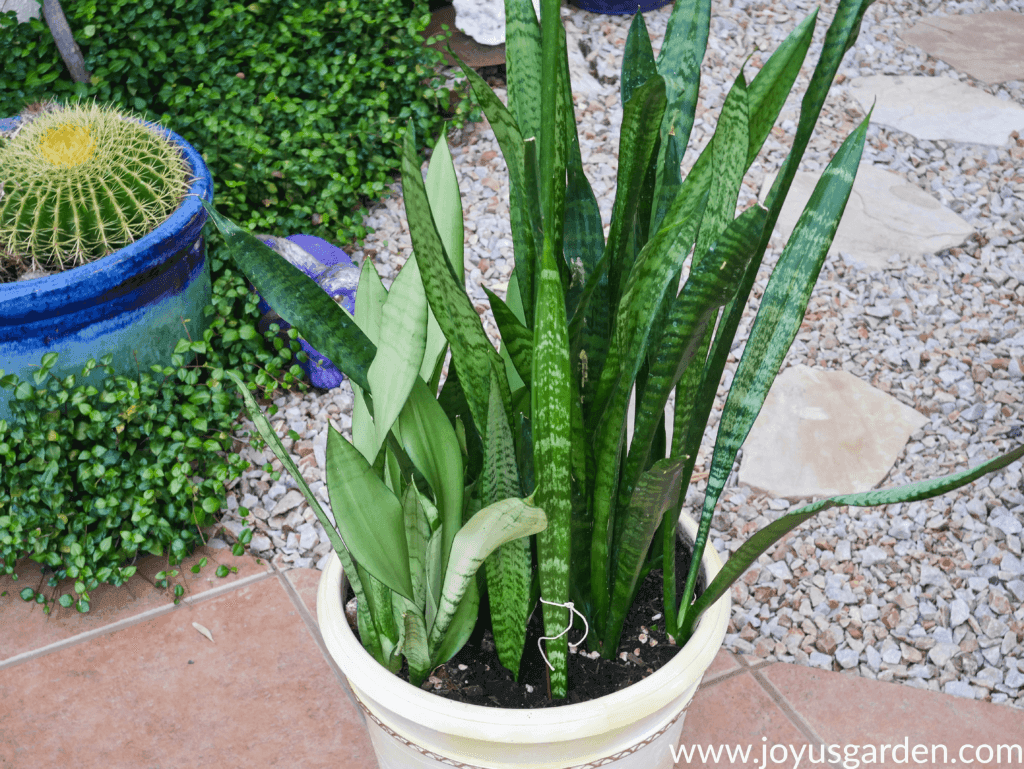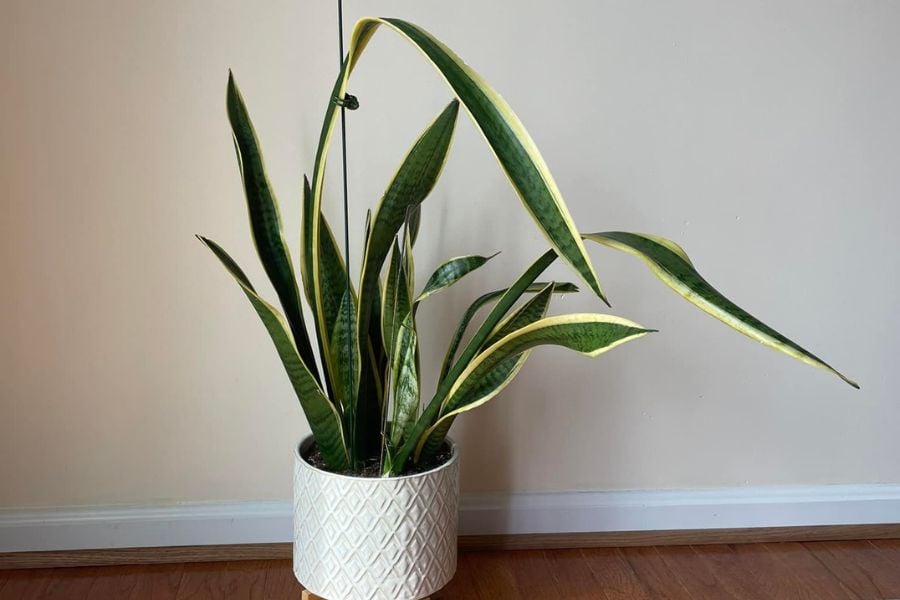The snake plant, also known as mother-in-law’s tongue, is a popular houseplant known for its upright sword-like leaves and easy care nature. However, over time, a snake plant can grow quite tall and start leaning or falling over, making it look unruly.
If your snake plant is getting too tall and unstable, don’t worry! With some simple maintenance and care adjustments, you can keep your plant looking tidy and prevent it from toppling over. This guide will discuss why snake plants get so tall, signs your plant is too top-heavy, and what you can do to fix an overgrown, floppy snake plant.

Understanding Why Snake Plants Get So Tall
Snake plants have a naturally tall, upright growth habit In their native tropical environments, they thrive in rocky soil and need to grow tall to reach sunlight through other vegetation Indoors, factors like the following also cause a snake plant to rapidly gain height
- Older plants – Snake plants grow outward slowly, but upward quickly. Over many years, they can reach ceiling height if left untrimmed!
- Ideal conditions – When a snake plant receives bright light, adequate water, and fertilizer, it will grow faster and taller.
- Few flower spikes – If a snake plant isn’t blooming regularly, more energy goes to vertical leaf growth
- Seeking light – When light is insufficient, a snake plant grows upward looking for brighter light sources.
- Sparse pruning – With no maintenance trimming back, snake plants keep increasing in height year after year.
- Tight spaces – In crowded pots or tight areas, snake plants focus energy on upward growth more than outward.
While a fast growing, towering snake plant may seem like a sign of good health, too much height can actually cause problems. It’s best to keep your plant contained to a reasonable size.
How To Fix an Overly Tall Snake Plant
If your snake plant is too tall and starting to fold or fall over, use these solutions:
- Trim it back – Cut the tallest leaves back by 1/3 or 1/2 to reduce the plant’s height. Make cuts just above another leaf.
- Split and repot – Gently divide the plant into pups or sections and repot separately to start new shorter plants.
- Stake it – Insert one or more stakes into the soil and gently tie outer leaves to keep them upright.
- Sit it inside something heavy – Place the pot inside a heavier cache pot or plant saucer to lower and stabilize the center of gravity.
- Change direction – Turn or angle the pot so the leaves growing against a wall or corner are forced to stay compact.
- Reduce crowding – Repot into a wider vessel so the plant can grow outwards and not just upwards.
- Optimize conditions – Ensure proper sunlight, fertilizing, and water to discourage excessive stretch upwards.
- Prune annually – Make regular height reduction trims part of your snake plant’s yearly care regimen.
With some simple pruning, staking, rotating, and general maintenance, you can keep your snake plant maintained at a tidy, manageable height even as it matures.
Signs Your Snake Plant is Getting Too Tall
Watch for these signs that your snake plant is getting overly tall and top-heavy:
- Leaves growing almost to the ceiling or starting to bend over
- A heavy leaning or swaying plant that seems unstable
- Outer leaves flopping over since the core can’t support them
- Previous leaves falling over limply as new leaves still push upward
- Wobbling or tipping from minor bumps due to a high center of gravity
- Congestion or crowding at the top while lower leaves droop downward
- New growth focused only at the top rather than throughout
- Flower spikes that cause the whole plant to tilt to one side
- Difficulty keeping the plant upright and requiring frequent staking
If you notice these signs, it’s time to take action to get your snake plant back to a reasonable size before it collapses under its own weight or height.
How to Trim a Snake Plant
Trimming back overgrown leaves is the most direct way to get an unruly snake plant back to an appropriate size. Here are some tips:
- Sterilize pruners to avoid disease transmission.
- Remove spent flowers and limp outer leaves first.
- Identify the tallest leaves to trim back by at least one half.
- Make cuts nice and clean just above another leaf.
- Aim for symmetrical height on both sides.
- Leave at least 2-3 inches at the base when trimming.
- Repot trimmed tops to propagate new plants.
- Repeat pruning yearly to maintain ideal height.
Regular trimming encourages the plant to grow bushier, not just taller. Time it about one month before the active growing season.
How to Stake a Floppy Snake Plant
Inserting stakes into the soil is useful for leaves that insist on flopping over sideways at the top:
- Use thin bamboo stakes or plant supports.
- Choose inconspicuous spots to insert stakes.
- Angle stakes to offer support where leaves tilt.
- Gently tie limp leaves to stakes with twist ties or soft ties.
- Wrap stems in cloth or foam to prevent injury from contact.
- Check ties monthly, removing ones on thicker, firmer leaves.
Proper staking can remedy moderate leaning and keep leaves growing upwards. Just avoid over-constricting tender leaves that need room to expand.
When to Consider Dividing Overgrown Snake Plants
If your snake plant is overcrowded with leaves competing for space, division may be the best option:
- Watch for congestion and leaves emerging sideways instead of upright.
- Choose a mature plant that is large enough to divide.
- Carefully remove from pot and split dense rhizome root mass using sanitized knife.
- Select pups or bunches of leaves to separate into individual plants.
- Repot divisions each into a fresh potting mix and container.
- Water well initially and grow in bright light until established.
Dividing overstuffed snake plants helps reduce their height while giving you new plants! Just allow divisions time to settle in before resuming fertilizing.
Preventing Future Overgrowth
Once you get your snake plant back into shape, implement these tips to prevent it overgrowing again:
- Prune regularly to contain height – don’t allow it to grow unchecked.
- Repot in a wider vessel as the plant expands.
- Provide optimal sunlight without scorching leaves.
- Allow 2-3 flower spikes annually since they use energy.
- Water appropriately for the size to avoid excessive growth spurts.
- Use a balanced liquid fertilizer at 1/2 strength during the growing season.
- Monitor for pests like mealybugs that can distort growth.
- Rotate the pot to influence direction of leaf emergence.
With attentive maintenance and care optimized for the plant’s maturity, you can enjoy your snake plant for years without it turning into a towering behemoth! Just get into the habit of containment pruning.
Is Your Snake Plant Too Tall? – Things You Need to Know
FAQ
Why are my snake plant leaves falling over?
Here are the things that could make that happen. The number one cause of snake plant leaves falling over is too much water. Like other succulents, snake plants store water in their leaves and need less water than most houseplants to survive. Overwatering a snake plant makes its soil soggy, keeps roots from breathing, and causes them to rot and die.
Can snake plants grow too tall?
Two solutions for excessively tall snake plants: Cut off only the excessively tall leaves and try propagating them through leaf cuttings. It’s challenging to thicken etiolated leaves that have become elongated, thin, and weak. So instead, adjust the plant’s location and wait for healthier leaves to grow.
Why do snake plants flop over?
Giving a snake plant too little water and not enough light can also make the plant’s leaves fall over, says Paris Lalicata, plant education expert for the online plant seller The Sill. Without enough light, a snake plant can’t make enough energy to maintain itself. It will slowly weaken and the leaves will flop over.
How to fix overgrown snake plants?
Here, I will introduce two leading solutions for overgrown snake plants. The leaves of an overgrown snake plant will start to fall over because of etiolation. In this case, you could use a ring support stake. Even though this may not be the best solution, slowly letting the plant get more sunlight may help the fallen leaves strengthen.
- The Ultimate Guide to Growing Strawberries in Raised Beds - August 8, 2025
- No-Dig Garden Beds: The Easiest Way to Grow a Beautiful Garden - August 6, 2025
- How to Protect and Preserve Wood for Raised Garden Beds - August 6, 2025

